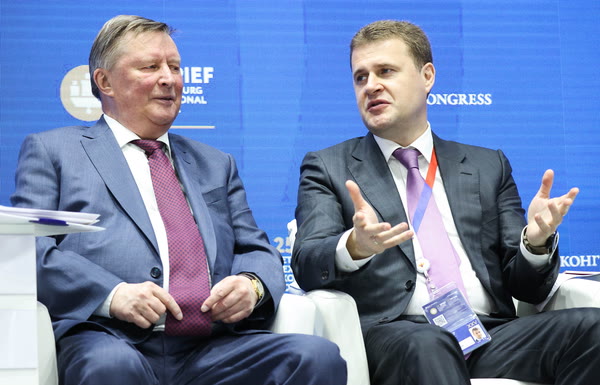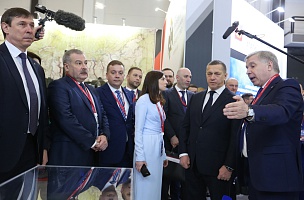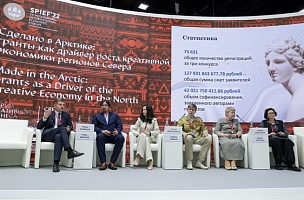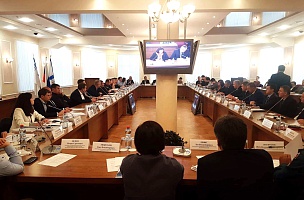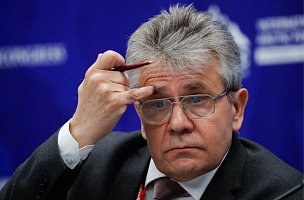Key conclusions
The NSR is a Major Artery for International Shipping and for Domestic Freight Transportation that Might be Popular with Many Countries
“We believe that the turn to the East may take place only through the North because we know directly how fully loaded all our Far East channels are, the railways, ports and frontier crossings. And we know the significance of the economy of the North. […] two trillion roubles a year are invested in each of these projects [investment projects implemented in the Far East – Ed.] and the state’s purpose is precisely to enable the structure of the NSR to correspond because today we cannot provide for export of the goods volumes, we already see by the capacities that are available and that are so far contained in strategic planning documents”, Alexey Chekunkov, Minister of the Russian Federation for the Development of the Far East and the Arctic.
“We are not closed to international cooperation and never will be; it’s another matter that we are currently presiding over the Arctic Council and the other seven member countries have stated that they do want to have anything more to do with Russia. If they don’t want to, too bad, but this won’t change the geography. Sooner or later, they will themselves come to the conclusion that, without us, trying to deal with the Arctic is pointless. […] All countries of the world are equally interested […] in taking the Northern Sea Route; nor do we have any interest in stopping them from doing so because that would deprive us of enormous profits. […] We do not need import substitution to provide for the Northern Sea Route since we already have everything: the most advanced technologies of the companies that create the ice-breaker fleet”, Sergei Ivanov, Special Representative of the President of the Russian Federation for Environment Protection, Ecology and Transport.
Sufficient Funds are Being Allocated to Creating the Conditions for Increasing Volumes Shipped Along the NSR but more Attention Should be Focused on Developing the Eastern Part of the Arctic
“We cannot do without the Northern Sea Route, without reliable routes in the north, and there will be ice-breakers. The key question is about localisation. […] Will another shipbuilding centre be established”, Alexey Rakhmanov, Chairman of the Board, CEO, United Shipbuilding Corporation.
“The shipping rates since the project was launched have been truly impressive: in 2018, the Northern Sea Route project – 9.1 million tonnes of cargo, 2019 – 19.6 million tonnes, the same in 2020 and in 2021 – 20.4 million tonnes. Yamal LNG is an integrated project for extraction, liquefication, transportation and sales but the project enjoys enormous advantages over other northern projects: the plant and port are located on the shore of the Northern Sea Route, allowing the project direct access by sea to the market of Europe and Asia”, Evgeniy Ambrosov, Deputy Chairman of the Management Board, NOVATEK.
“The main thing is not to reduce the plans for building ice-breakers. […] The volume of cargo is growing by the year along the Northern Sea Route and this is the priority. Floating nuclear power stations. For the Northern Sea Route, floating nuclear power stations: for development of a major power industry for the same coal and gas deposits, power is needed for everything. […] The priority for the Northern Sea Route is to go only in an easterly direction, a lot is still unclear owing to geopolitics but I believe it a fact that our export volumes to the East will grow substantially but shrink to the West. The eastern sector of the Arctic needs to be developed though this is the most difficult in terms of the ice situation, laying everything, lack of the necessary shore facilities, and security. We have one serious unresolved task along the Northern Sea Route: we must consider the theoretical possibility of accidents, God forbid catastrophes. We have to consider this because this is our shore zone, our shore and, if something happens, it will be for us to clear it up”, Sergei Ivanov, Special Representative of the President of the Russian Federation for Environment Protection, Ecology and Transport.
PROBLEMS
Absence of Strict Environmental Criteria for Navigation Along the NSR
“Our Ministry of Natural Resources must develop very precise and very strict, the strictest environmental standards by class of vessel that will sail especially through the eastern sector of the Arctic. They must decide: how many decks each vessel should have, and all the vessels must abide by the rules stipulated by the Ministry from the environmental perspective because, from this point of view, the Arctic is the most vulnerable place on Earth. The most dangerous place when it comes to environmental harm. And we have to control this since the main sector of the Arctic belongs to the Russian Federation”, Sergei Ivanov, Special Representative of the President of the Russian Federation for Environment Protection, Ecology and Transport.
An Increase in Freight Loads Travelling Along the NSR Will Trigger Logistics and Freight Delivery Problems
“In Archangelsk, the cargo turnover at our port is growing absolutely confidently, […] shippers say today that the problem is that there is not a single free slot for two months ahead and the entire port capacity is booked showing that the port can no longer cope with demand. We are developing, building a new dockside and investors have put great trust in the future of the Northern Sea Route. But there is a problem preventing us from increasing cargo turnover at all substantially in two or three years. This is the question of rapid construction of appropriate infrastructure, above all the railway infrastructure”, Alexander Tsybulskiy, Governor of Archangelsk Region.
“We understand that we must distribute our competencies, our technologies, our development resources as broadly as possible: this means our shipbuilding in general […] and expansion of the support infrastructure, and creation of digital services along the Northern Sea Route hinterland. Strictly speaking, over the next 18 months, we need to create an ice navigator similar to a vehicle satnav showing us the best route from the angle of traffic jams, the weather, ice conditions and logistics in general. This is all a major task for us”, Alexey Likhachev, Director General, State Atomic Energy Corporation ROSATOM.
“To provide for development of the Northern Sea Route infrastructure, we are now building 37 vessels, including a certain number of nuclear-powered ice-breakers. […] As for big Arctic class, ice-breaker class, large tonnage vessels – this is Zvezda, a super-wharf, but again: 32 vessels are currently on order, with another 50 potential orders, but this also depends on how the customers and operators feel, what will happen with their projects, their cargo volumes”, Viktor Evtukhov, Secretary of State – Deputy Minister for Industry and Trade of the Russian Federation.
SOLUTIONS
Creation of New Economic Regimes and Ship Building, Development of Search and Recovery of People Under NSR Conditions by the Emergencies Ministry, Companies and Regions
“Murmansk is the base port for developing the Northern Sea Route. […] The key aspects include: development of Murmansk port as the only ice-free port in the North, transformation of the Murmansk transport hub into a multimodal hub and construction there of new transhipment terminals, development of ship repairs. […] Two special regimes have emerged: an advanced development zone and the Arctic Zone of the Russian Federation, giving a powerful boost to our economy’s development”, Andrey Chibis, Governor of Murmansk Region.
“The difficult Arctic ice conditions, with which we have coped […] quite effectively: […] a unique fleet has already been created, […] [gas carriers – Ed.], which arrive at the port of Sabetta every day of the year. Yamal LNG today owns a unique fleet of gas carriers that virtually no one else in the world possesses. […] The task is – to develop the eastern sector of the Arctic, while year-round use of the western sector is already established. […] From the beginning of the year, together with shipowners, we completed, for the first time, introducing a constant monitoring system for vessel and vessel mechanism operation indicators, and this system enables us to collect, accumulate and visualise the primary data reaching us online from ships, and to exercise real time control over ship operation. As per the users’ settings, the system itself analyses the data as they come in, identifies divergencies and signals the operator, which, under the operating conditions along the Northern Sae Route, makes cargo delivery to buyers materially more reliable”, Evgeniy Ambrosov, Deputy Chairman of the Management Board, NOVATEK.
“What does 112 [an emergency – Ed.] mean in the Arctic zone? We are already launching a study. […] From 2027, we want to increase the aviation component substantially: above all, by rotary-wing aircraft. We have a programme for 13 helicopters, including 9 adapted for service in the north, in the Arctic – the MI-38. We are continuing construction of Arctic centres. […] The President [of Russia, Vladimir Putin, – Ed.] has set us the task, in conjunction with NOVATEK and Rosneft, of participating in building these centres. […] The Government has tasked us with developing an Arctic zone safety standard. I am sure that we will need more than one GOST state safety standard”, Alexander Chupriyan, First Deputy Minister of the Russian Federation for Civil Defence, Emergencies and Elimination of the Consequences of Natural Disasters.
“We have a number of interesting proposals, particularly regarding setting up rescue stations, […] concrete hydro-blocks or artificial islands, if you like, which we believe are suitable for ensuring safe navigation and rescuing people. Not on the melting shore, since warming is under way, but in the sea, as close as possible to the shipping lanes. We are prepared to take up this technology and bring it to industrial implementation”, Alexey Rakhmanov, Chairman of the Board, CEO, United Shipbuilding Corporation.
For more details, see the ROSCONGRESS.ORG Information and Analytical System.


